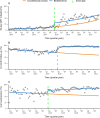The impact of a comprehensive strategy on HIV treatment continuum in a highly endemic area of China: an interrupted time series analysis
- PMID: 40217160
- PMCID: PMC11992854
- DOI: 10.1186/s12879-025-10861-2
The impact of a comprehensive strategy on HIV treatment continuum in a highly endemic area of China: an interrupted time series analysis
Abstract
Background: A comprehensive strategy encompassing universal testing and strengthened treatment was promoted to address the severe HIV epidemic in Liangshan. This study aimed to assess the impact of this strategy on HIV treatment continuum.
Methods: Interrupted time series (ITS) analysis was utilized to evaluate the impact of a comprehensive strategy on HIV treatment outcomes in Liangshan from 2014 to 2021 utilizing data from China's HIV/AIDS Comprehensive Response Information Management System (CRIMS). Poisson or quasi-Poisson segmented regression models were applied to estimate the trends and immediate changes in key outcomes, including the proportion of 30-day antiretroviral therapy (ART) initiation, the proportion of 6-month follow-up, and the proportion of viral suppression, following the strategy's implementation in January 2018. The analysis was stratified by sex, age, transmission route, and region, with areas classified as key areas and non-key areas based on an HIV prevalence threshold of 1%.
Results: A total of 37,888 people living with HIV (PLHIV) were identified during the study period, with an increase in diagnoses following comprehensive strategy implementation. Most cases involved males, aged 15-34 years, residents of key areas, and individuals infected through heterosexual transmission. There was a significant increase of 2.50-fold in 30-day ART initiation (incidence rate ratio [IRR] 2.501, 95% CI: 1.694-3.694), 34.0% in 6-month follow-up (1.340, 95% CI: 1.234-1.456), and 17.7% in viral suppression (1.177, 95% CI: 1.068-1.296) in the first month of comprehensive strategy implementation. Over time, all three indicators displayed an upward trend, and by December 2021, their predicted values significantly increased, exceeding the expected levels by 60.3% (IRR 1.603, 95% CI: 1.108-2.318), 62.9% (1.629, 95% CI: 1.430-1.855), and 50.6% (1.506, 95% CI: 1.223-1.855), respectively. Subgroup analysis revealed that while the strategy's effects on these outcomes were generally consistent, the magnitude of improvement varied. Residents of key areas exhibited more significant increases in 30-day ART initiation, while residents of non-key areas, particularly those aged ≥ 60 years, displayed smaller increases in the proportion of 6-month follow-up, and no significant change in the proportion of viral suppression, with a slightly lower average.
Conclusions: The implementation of a comprehensive strategy substantially improved timely ART initiation, follow-up care after ART and viral suppression for PLHIV in Liangshan, with consistent enhancements across various subpopulations. It is imperative to strengthen comprehensive strategy in non-key areas of Liangshan, and to promote these strategies in other similar regions in order to enhance health benefits for patients.
Keywords: Antiretroviral therapy; HIV; Interrupted time series (ITS); Universal test and strengthened treatment.
© 2025. The Author(s).
Conflict of interest statement
Declarations. Ethics approval and consent to participate: The Institutional Review Board of National Center for AIDS/STD Control and Prevention, Chinese Center for Disease Control and Prevention (X140121318) gave ethical approval for this study. Since all data were deidentifed and provided in the aggregated form, the informed consent was waived. All methods were performed in accordance with the Declaration of Helsinki. Consent for publication: Not applicable as all data are presented in the aggregate. Competing interests: The authors declare no competing interests.
Figures


Similar articles
-
Immediate and long-term outcomes after treat-all among people living with HIV in China: an interrupted time series analysis.Infect Dis Poverty. 2023 Aug 14;12(1):73. doi: 10.1186/s40249-023-01119-7. Infect Dis Poverty. 2023. PMID: 37580822 Free PMC article.
-
The impact of the COVID-19 lockdown on HIV care in 65 South African primary care clinics: an interrupted time series analysis.Lancet HIV. 2021 Mar;8(3):e158-e165. doi: 10.1016/S2352-3018(20)30359-3. Epub 2021 Feb 4. Lancet HIV. 2021. PMID: 33549166 Free PMC article.
-
Early outcomes after implementation of treat all in Rwanda: an interrupted time series study.J Int AIDS Soc. 2019 Apr;22(4):e25279. doi: 10.1002/jia2.25279. J Int AIDS Soc. 2019. PMID: 30993854 Free PMC article.
-
Population uptake of HIV testing, treatment, viral suppression, and male circumcision following a community-based intervention in Botswana (Ya Tsie/BCPP): a cluster-randomised trial.Lancet HIV. 2020 Jun;7(6):e422-e433. doi: 10.1016/S2352-3018(20)30103-X. Lancet HIV. 2020. PMID: 32504575 Free PMC article. Clinical Trial.
-
Temporal changes in paediatric and adolescent HIV outcomes across the care continuum in Zambia: an interrupted time-series analysis.Lancet HIV. 2022 Aug;9(8):e563-e573. doi: 10.1016/S2352-3018(22)00127-8. Lancet HIV. 2022. PMID: 35905754 Free PMC article.
References
-
- Liu LH, Liu L, Yu G, Hu Y, Liang L, Pei XD, et al. Epidemic characteristics and trend among newly reported HIV cases in Liangshan prefecture from 2005 to 2016. Chin J AIDS STD. 2018;24(4):345-347,356.
-
- Wang QX, Gong YH, Nan L, Ma MJ, Yin BB, Ma ZJ, et al. Analysis on the results of sampling survey for HIV infection among rural population in 14 counties of Liangshan prefecture[J]. Mod Prev Med. 2015;42(2):328-331,350.
-
- Xu JL, Jike CN, Ma Y, Yu G, Wang J, Wang K, et al. Effects and associated factors of HIV/AIDS anti retroviral therapy in Liangshan Yi Autonomous Prefecture, Sichuan Province[J]. Chin J Prev Med. 2018;52(6):668–72. - PubMed
-
- Yu H, Wang J, He L, Zeng YL, Mao A, Zhuo-ma LC, et al. Analysis of antiviral treatment effect and its influencing factors in HIV high prevalence counties of Liangshan Prefecture[J]. J Prev Med Inf. 2022;38(10):1313–20.
MeSH terms
Substances
LinkOut - more resources
Full Text Sources
Medical

